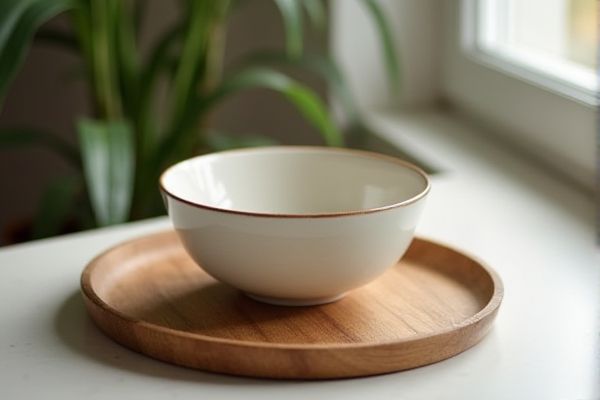
Ceramic bowls offer durability and heat resistance, making them ideal for serving hot dishes, while wooden trays provide a rustic aesthetic and lightweight versatility perfect for carrying multiple items. Discover which option best suits Your dining needs by exploring the rest of this article.
Table of Comparison
| Feature | Ceramic Bowl | Wooden Tray |
|---|---|---|
| Material | Fired clay with a glazed finish | Natural hardwood or bamboo |
| Durability | Fragile, prone to chipping and cracking | Sturdy, resistant to impact and bending |
| Weight | Heavier, solid construction | Lighter, easy to carry |
| Maintenance | Dishwasher safe, requires careful handling | Hand wash only, needs periodic oiling |
| Heat Resistance | High, suitable for hot foods and microwaving | Low, not microwave or oven safe |
| Design & Aesthetics | Glossy, colorful, smooth texture | Natural grain, rustic, warm appearance |
| Use Cases | Serving soups, salads, desserts | Serving drinks, appetizers, organizing items |
| Environmental Impact | Non-renewable energy in firing, recyclable | Renewable, biodegradable, sustainable if sourced responsibly |
| Cost | Moderate to high depending on design | Generally lower, varies with wood type |
Introduction to Ceramic Bowls and Wooden Trays
Ceramic bowls offer durability, heat resistance, and an elegant aesthetic, making them ideal for serving hot dishes and soups. Wooden trays provide a lightweight, natural look with excellent grip, perfect for carrying multiple items or presenting appetizers. Selecting between ceramic bowls and wooden trays depends on your needs for functionality and style in the kitchen.
Material Composition and Durability
Ceramic bowls are crafted from fired clay, offering a dense, non-porous surface that resists stains and heat, making them highly durable for everyday use and dishwasher safe. Wooden trays, typically made from hardwoods like teak or acacia, provide natural resistance to moisture and wear while requiring regular oiling to maintain durability and prevent cracking. Both materials combine aesthetic appeal with functional longevity, though ceramic excels in heat resistance and ease of cleaning, whereas wood offers lightweight versatility and a warm, tactile texture.
Aesthetic Appeal and Design Variety
Ceramic bowls offer a glossy finish and vibrant color options that enhance visual appeal in various dining settings. Wooden trays provide a natural, rustic look with unique grain patterns, adding warmth and texture to table presentations. Both materials present diverse design choices, with ceramics favoring smooth, intricate patterns and wood emphasizing organic shapes and handcrafted details.
Functionality and Everyday Use
Ceramic bowls offer excellent heat retention and are ideal for serving hot soups, stews, and salads, making them a staple in everyday kitchen use. Wooden trays provide a lightweight, durable surface perfect for carrying multiple items and serving snacks or beverages while adding a natural aesthetic. Both items complement daily functionality, with ceramic bowls focused on food containment and wooden trays enhancing portability and presentation.
Maintenance and Cleaning Requirements
Ceramic bowls require gentle cleaning with non-abrasive sponges to avoid scratches and are generally dishwasher-safe, making maintenance straightforward. Wooden trays need regular oiling with food-safe mineral oil to prevent cracking and warping, and should be hand-washed promptly to avoid water damage. Both materials benefit from thorough drying after cleaning to maintain their durability and appearance.
Heat and Moisture Resistance
Ceramic bowls offer superior heat resistance thanks to their ability to withstand high temperatures without warping or releasing harmful chemicals, making them ideal for hot foods and microwaving. Wooden trays excel in moisture resistance by naturally repelling water, but prolonged exposure to heat or moisture can cause cracking or warping over time. Your choice between ceramic and wooden serveware should consider whether heat tolerance or moisture durability is more crucial for your kitchen needs.
Environmental Impact and Sustainability
Ceramic bowls offer durability and are often made from natural clay materials, yet their production involves high energy consumption and mining processes that impact the environment. Wooden trays, sourced from renewable resources, provide a biodegradable and recyclable alternative with a lower carbon footprint when sustainably harvested. Choosing FSC-certified wood products further enhances sustainability, reducing deforestation and promoting responsible forestry management.
Suitability for Different Culinary Presentations
Ceramic bowls excel in showcasing vibrant salads, soups, and stews due to their smooth, glossy surfaces that enhance colors and textures, making them ideal for elegant dining presentations. Wooden trays offer a rustic, natural aesthetic perfect for serving charcuterie, breads, and appetizers, creating a warm and inviting atmosphere for casual or artisanal food displays. Choosing between a ceramic bowl and wooden tray depends on your desired culinary presentation style, with each complementing specific dish types to elevate the overall dining experience.
Price Range and Value for Money
Ceramic bowls typically range from $10 to $50, offering durability and aesthetic appeal that justify their moderate price point, making them a cost-effective choice for both everyday use and decorative purposes. Wooden trays vary widely in price, from $20 to over $100, depending on the type of wood and craftsmanship, providing excellent value for those seeking a natural, rustic look with long-lasting quality. When evaluating value for money, ceramic bowls excel in versatility and maintenance, while wooden trays deliver superior durability and a timeless design, catering to different functional and stylistic needs.
Conclusion: Choosing Between Ceramic Bowls and Wooden Trays
Ceramic bowls offer durability, heat resistance, and a sleek, modern aesthetic perfect for serving hot dishes, while wooden trays provide a lightweight, rustic charm ideal for presenting multiple items and enhancing table decor. Your choice depends on the intended use: ceramic bowls excel in functionality for food preparation and serving, whereas wooden trays prioritize versatility and visual appeal. Selecting between them hinges on balancing practical needs with stylistic preferences in your dining experience.
 homyna.com
homyna.com